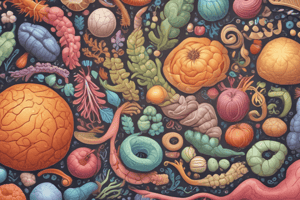Podcast
Questions and Answers
What is the primary function of polysaccharides in the body?
What is the primary function of polysaccharides in the body?
- To facilitate communication between cells
- To act as enzymes
- To transport oxygen in the blood
- To provide structural materials and energy (correct)
Which type of amylase is found in saliva and pancreatic juice?
Which type of amylase is found in saliva and pancreatic juice?
- β-amylase
- γ-amylase
- δ-amylase
- α-amylase (correct)
What type of linkage is present in amylose?
What type of linkage is present in amylose?
- β-1,4 glycosidic bonds
- α-1,4 glycosidic bonds (correct)
- γ-1,5 glycosidic bonds
- α-1,6 glycosidic bonds
What distinguishes amylopectin from amylose?
What distinguishes amylopectin from amylose?
Why are starches considered convenient storage materials?
Why are starches considered convenient storage materials?
What is a characteristic of pure starch?
What is a characteristic of pure starch?
Which of the following occurs during the hydrolysis of starch?
Which of the following occurs during the hydrolysis of starch?
In which structures is starch primarily stored?
In which structures is starch primarily stored?
What structural feature distinguishes inulin from starch?
What structural feature distinguishes inulin from starch?
Which of the following correctly describes the action of dietary fiber in the body?
Which of the following correctly describes the action of dietary fiber in the body?
What is a defining characteristic of glycosaminoglycans?
What is a defining characteristic of glycosaminoglycans?
Which of the following statements about mucopolysaccharidoses is true?
Which of the following statements about mucopolysaccharidoses is true?
Which compound is indicated by a blue color reaction when iodine is applied?
Which compound is indicated by a blue color reaction when iodine is applied?
What is the role of proteoglycans in the body?
What is the role of proteoglycans in the body?
What type of bonds link D-glucose units in glycogen?
What type of bonds link D-glucose units in glycogen?
Which of the following is a potential consequence of consuming too much dietary fiber?
Which of the following is a potential consequence of consuming too much dietary fiber?
What structural characteristic differentiates amylopectin from amylose?
What structural characteristic differentiates amylopectin from amylose?
What is the primary molecular interaction that allows starch to function as a storage material?
What is the primary molecular interaction that allows starch to function as a storage material?
Which type of linkage does NOT occur in amylose?
Which type of linkage does NOT occur in amylose?
Which statement accurately describes α-amylase?
Which statement accurately describes α-amylase?
What is a defining characteristic of the pure starch composition?
What is a defining characteristic of the pure starch composition?
Which condition is associated with polysaccharide metabolism issues?
Which condition is associated with polysaccharide metabolism issues?
What is the primary function of polysaccharides in biological systems?
What is the primary function of polysaccharides in biological systems?
What type of amylase exists in sprouted grains and malts?
What type of amylase exists in sprouted grains and malts?
Which characteristic relates to the hydrolysis of starch?
Which characteristic relates to the hydrolysis of starch?
What role does amylose play in starch’s overall structure?
What role does amylose play in starch’s overall structure?
What is the primary structural feature of inulin?
What is the primary structural feature of inulin?
Which statement accurately describes the molecular weight of inulin compared to starch?
Which statement accurately describes the molecular weight of inulin compared to starch?
How do glycosaminoglycans primarily differ from homopolysaccharides?
How do glycosaminoglycans primarily differ from homopolysaccharides?
What is the consequence of a deficiency in lysosomal enzymes related to mucopolysaccharides?
What is the consequence of a deficiency in lysosomal enzymes related to mucopolysaccharides?
What causes the yellow color reaction of inulin when iodine is applied?
What causes the yellow color reaction of inulin when iodine is applied?
What roles do dietary fibers mostly fulfill in the digestive system?
What roles do dietary fibers mostly fulfill in the digestive system?
Which compound produces a violet color reaction when iodine is applied?
Which compound produces a violet color reaction when iodine is applied?
What are proteoglycans primarily composed of?
What are proteoglycans primarily composed of?
What defines the structure of starch as a polysaccharide?
What defines the structure of starch as a polysaccharide?
Which characteristics distinguish mucopolysaccharidoses as genetic disorders?
Which characteristics distinguish mucopolysaccharidoses as genetic disorders?
Flashcards
Polysaccharides
Polysaccharides
Large, complex carbohydrates made of many simple sugar units. They are insoluble and high molecular weight.
Starch Structure
Starch Structure
A storage polysaccharide in plants, composed of amylose (linear) and amylopectin (branched) chains of glucose.
Amylose
Amylose
A linear chain of glucose molecules linked by α(1→4) glycosidic bonds in starch.
Amylopectin
Amylopectin
Signup and view all the flashcards
α-amylase
α-amylase
Signup and view all the flashcards
β-amylase
β-amylase
Signup and view all the flashcards
Starch Function
Starch Function
Signup and view all the flashcards
Hydrolysis of Starch
Hydrolysis of Starch
Signup and view all the flashcards
Glycogen structure
Glycogen structure
Signup and view all the flashcards
Amylose vs. Amylopectin
Amylose vs. Amylopectin
Signup and view all the flashcards
Inulin structure
Inulin structure
Signup and view all the flashcards
Dietary fiber function
Dietary fiber function
Signup and view all the flashcards
Proteoglycans
Proteoglycans
Signup and view all the flashcards
Mucopolysaccharidoses (MPS)
Mucopolysaccharidoses (MPS)
Signup and view all the flashcards
Glycosaminoglycans (GAGs)
Glycosaminoglycans (GAGs)
Signup and view all the flashcards
Storage Polysaccharides
Storage Polysaccharides
Signup and view all the flashcards
What are polysaccharides?
What are polysaccharides?
Signup and view all the flashcards
What are the main functions of polysaccharides?
What are the main functions of polysaccharides?
Signup and view all the flashcards
Starch
Starch
Signup and view all the flashcards
What are amylases?
What are amylases?
Signup and view all the flashcards
Glycogen
Glycogen
Signup and view all the flashcards
How is starch broken down?
How is starch broken down?
Signup and view all the flashcards
Inulin
Inulin
Signup and view all the flashcards
Dietary Fiber
Dietary Fiber
Signup and view all the flashcards
What is the function of dietary fiber?
What is the function of dietary fiber?
Signup and view all the flashcards
What are Mucopolysaccharidoses (MPS)?
What are Mucopolysaccharidoses (MPS)?
Signup and view all the flashcards
What is the difference between starch and glycogen?
What is the difference between starch and glycogen?
Signup and view all the flashcards
What are the bonds in starch?
What are the bonds in starch?
Signup and view all the flashcards
Study Notes
Polysaccharides
- Polysaccharides are high molecular weight carbohydrates
- They are insoluble and non-sugars
- On hydrolysis, they yield monosaccharides or products related to them
- They are polymeric anhydrides of simple sugars
- D-glucose is a common component
- Examples of other components include: D- and L-galactose, D-mannose, D-xylose, L-arabinose, D-glucoronic, D-galacturonic, D-mannuronic acids, D-glucoseamine, D-galactoseamine, and aminouronic acids
- Polysaccharides differ from each other based on molecular weight, chain nature (linear or branched), and type of glycosidic bonds (α or β)
Types of Polysaccharides
- Homopolysaccharides: Hydrolyze to yield a single monosaccharide
- Storage polysaccharides: starch, glycogen, inulin
- Structural polysaccharides: cellulose, pectin, chitin
- Heteropolysaccharides: Hydrolyze to yield a mixture of monosaccharides
- Glycosaminoglycans (e.g., hyaluronic acid, chondroitin sulfates A and C, dermatan sulfate): Structural components of connective tissues and mucous substances
Functions of Polysaccharides
- Energy storage: Starch (plants), glycogen (animals)
- Structural support: Cellulose (plant cell walls), chitin (exoskeletons)
- Polysaccharides are also used in industry for various applications including water treatment, pulp and paper, biomedical applications, cosmetics, biotechnology and agriculture
Starch
- A polymer of α-glucose
- Stored as granules in chloroplasts and storage organs of plants (e.g., potatoes, seeds)
- Two types of molecules: amylose (linear and helical) and amylopectin (branched)
- Amylases (α-amylase and β-amylase) are present in saliva and pancreatic juice; they hydrolyze α-glycosidic linkages, making starch easier to digest as sugars
Glycogen
- A polymer of α-glucose
- An animal storage polysaccharide, stored in liver and muscle
- More branched than starch, with branching after 8-10 residues, making it easily mobilized
- More compact form of energy storage compared to starch
Inulin
- Storage polysaccharide of the Compositae family (e.g., tubers of dahlia, artichoke, roots of dandelion)
- Lower molecular weight than starch
- Polymer of D-fructose, β-(1,2) linked fructofuranoses
- Linear, no branching
- Colors yellow with iodine
- Yields fructose on hydrolysis
Cellulose
- A structural polysaccharide in plant cell walls
- Polymer of β-D-glucose
- Linear, no branching
- Insoluble in water and lacks sweetness
- Provides structural support to plant cells
- Humans cannot digest cellulose due to the lack of an enzyme to break down β-glycosidic bonds
Pectin
- A structural component found in the middle lamella between cell walls and in ripe fruits (e.g., guava, apples, pears)
- A high molecular weight polysaccharide
- Chemically, it's a polysaccharide of α-D-galacturonic acid, with some carboxyl groups esterified with methyl alcohol or combined with calcium or magnesium ions.
- It has gelling properties and is used in the food industry as a thickener and gelling agent.
Chitin
- A structural polysaccharide found in fungi and exoskeletons of arthropods (e.g., crabs, insects)
- It is a polymer of N-acetyl-β-D-glucosamine
- It has excellent mechanical properties, providing support to the exoskeleton
Glycosaminoglycans (GAGs)
- Heteropolysaccharides
- Composed of repeating disaccharide units with an amino sugar and uronic acid
- Important components of connective tissues and play a role in lubrication
Hyaluronic acid
- Most abundant GAG
- Important component of synovial fluid (lubricant), vitreous body of the eye, and umbilical cord
- Straight-chain polymer of D-glucuronic acid and N-acetyl-D-glucosamine.
Chondroitin Sulfates
- Widely distributed in cartilage, tendons, and bones
- Essential for structural support in these tissues
- Formed from disaccharide units with D-glucuronic acid and N-acetyl-D-galactosamine, with sulfate groups
Dermatan Sulfate
- A sulfated mucopolysaccharide similar to chondroitin sulfate A, but has L-iduronic acid instead of D-glucuronic acid
Heparin
- An anticoagulant and found in liver, lung, and arterial walls
- It inhibits blood clotting by interfering with the conversion of prothrombin to thrombin
Proteoglycans
- Proteins conjugated with glycosaminoglycans (GAGs)
- Important structural components of connective tissues
Studying That Suits You
Use AI to generate personalized quizzes and flashcards to suit your learning preferences.




